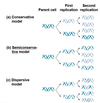chapter 16: DNA test 5 Flashcards
In 1953, ___ and ___ introduced an elegant double-helical model for the structure of deoxyribonucleic acid, or DNA
James Watson and Francis Crick
DNA is unique in its ability to ___. (and cells can repair their DNA)
When is DNA copied?
The resemblance of offspring to parents depends upon ___ and its transmission from one generation to the next
direct its own replication
information encoded in DNA
When T. H. Morgan’s group showed that genes are located ___, the two components of chromosome ___ became candidates for the genetic material
The role of DNA in heredity was first discovered
by studying microorganisms such as ___
on chromosomes
DNA and protein
bacteria and the viruses that infect them
The discovery of the genetic role of DNA began with research by ___ in 1928
Griffith worked with two strains of a bacterium (Streptococcus pneumoniae)
one strain: harmless
one strain: pathogenic (disease causing)
Frederick Griffith
(Frederick Griffith 1928 research: two strains of bacterium)
When he mixed heat-killed remains of the pathogenic strain with living cells of the harmless strain, some living cells became ___
He called this phenomenon ___, now defined as a change in ___ due to uptake of foreign DNA
genotype: genetic makeup
phenotype: physical observable characteristics (traits)
pathogenic
transformation
genotype and phenotype
(Evidence That Viral DNA Can Program Cells)
A virus is ___ (sometimes RNA) enclosed by a protective coat, often simply protein
To replicate, a virus infects a ___ and takes over the machinery.
Viruses that specifically attack bacteria are called ___ (or phages).
DNA
cell
bacteriophages
In 1952, Alfred Hershey and Martha Chase showed that DNA is the genetic material of a phage known as ___
They designed an experiment showing that only one of the two components of T2 (___) enters an E. coli (bacteria) cell during infection
They concluded that the injected DNA of the phage provides the genetic information (___)
T2
DNA or protein
transfection
(1952, Alfred Hershey and Martha Chase showed that DNA is the genetic material of a phage)
They concluded that the ___ of the phage provided the genetic information that made the infected cells produce new ___
injected DNA
viral DNA and proteins to assemble into new viruses.
(Additional Evidence That DNA Is the Genetic Material)
It was known that DNA is a polymer of nucleotides, each consisting of a ___, a ___, and a ___
Nitrogenous Bases: ___
nitrogenous base, a sugar, and a phosphate group
Adenine, Guanine, Cytosine, Thymine
In 1950, Erwin Chargaff reported that DNA composition ___ from one species to the next
This evidence of diversity made DNA a more credible candidate for the genetic material
varies
Two findings became known as Chargaff’s rules
- The base composition of DNA ___
- In any species the number of A and T bases are ___ and the number of G and C bases are ___
The basis for these rules was not understood until the discovery of the double helix
varies between species
equal, equal

After DNA was accepted as the genetic material, the challenge was to determine how its three dimensional structure accounts for its role in heredity
Maurice Wilkins and Rosalind Franklin were using a technique called ___ to study molecular structure
Franklin produced a picture of the DNA molecule using this technique
X-ray crystallography
Franklin’s X-ray crystallographic images of DNA enabled Watson to deduce that DNA was ___
The X-ray images also enabled Watson to deduce the width of the helix and the spacing of the nitrogenous bases
The pattern in the photo suggested that the DNA molecule was made up of two strands, forming a ___
helical
double helix
Franklin had concluded that there were two outer ___ backbones, with the ___ paired in the molecule’s interior
Watson built a model in which the backbones were parallel however their subunits run in opposite directions or are ___.
sugar-phosphate
nitrogenous bases
antiparallel











